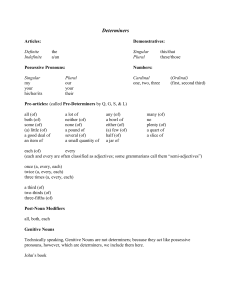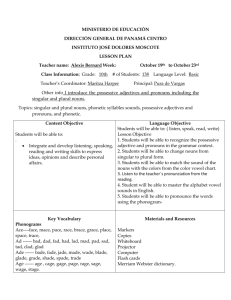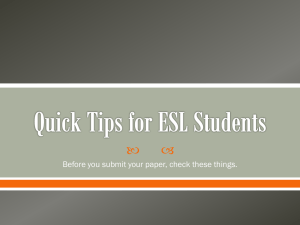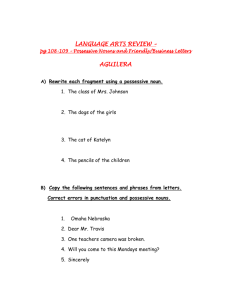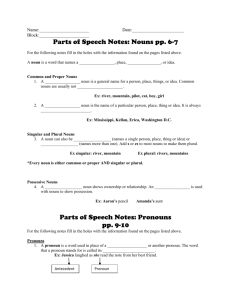Grammar Review - Immaculate Conception School
advertisement
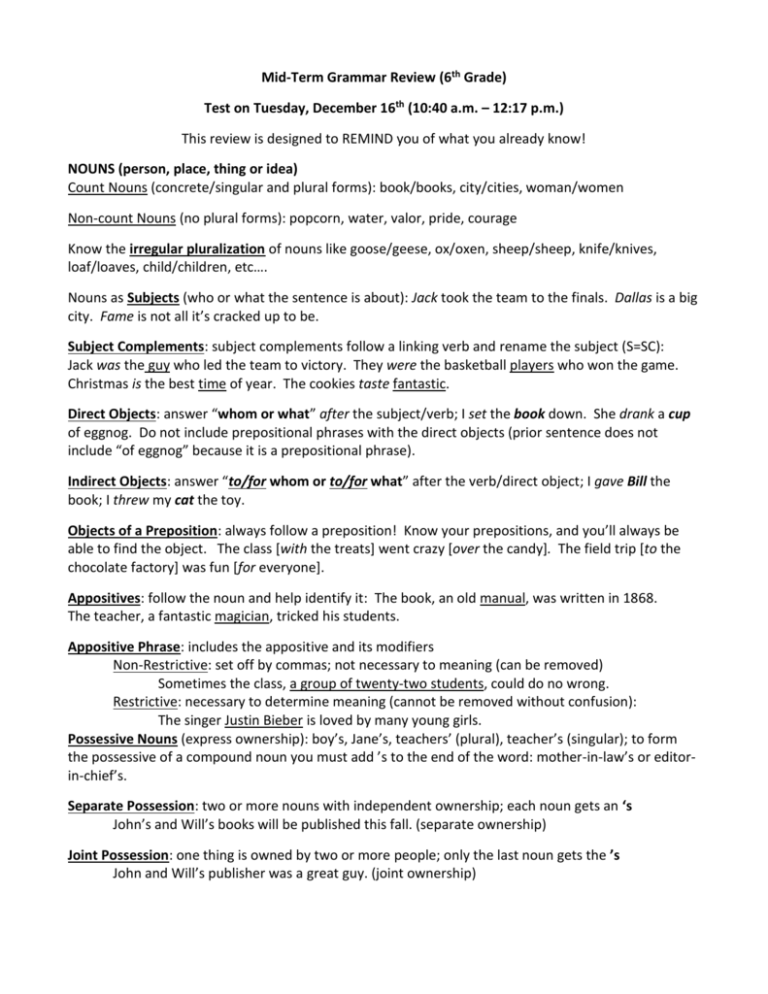
Mid-Term Grammar Review (6th Grade) Test on Tuesday, December 16th (10:40 a.m. – 12:17 p.m.) This review is designed to REMIND you of what you already know! NOUNS (person, place, thing or idea) Count Nouns (concrete/singular and plural forms): book/books, city/cities, woman/women Non-count Nouns (no plural forms): popcorn, water, valor, pride, courage Know the irregular pluralization of nouns like goose/geese, ox/oxen, sheep/sheep, knife/knives, loaf/loaves, child/children, etc…. Nouns as Subjects (who or what the sentence is about): Jack took the team to the finals. Dallas is a big city. Fame is not all it’s cracked up to be. Subject Complements: subject complements follow a linking verb and rename the subject (S=SC): Jack was the guy who led the team to victory. They were the basketball players who won the game. Christmas is the best time of year. The cookies taste fantastic. Direct Objects: answer “whom or what” after the subject/verb; I set the book down. She drank a cup of eggnog. Do not include prepositional phrases with the direct objects (prior sentence does not include “of eggnog” because it is a prepositional phrase). Indirect Objects: answer “to/for whom or to/for what” after the verb/direct object; I gave Bill the book; I threw my cat the toy. Objects of a Preposition: always follow a preposition! Know your prepositions, and you’ll always be able to find the object. The class [with the treats] went crazy [over the candy]. The field trip [to the chocolate factory] was fun [for everyone]. Appositives: follow the noun and help identify it: The book, an old manual, was written in 1868. The teacher, a fantastic magician, tricked his students. Appositive Phrase: includes the appositive and its modifiers Non-Restrictive: set off by commas; not necessary to meaning (can be removed) Sometimes the class, a group of twenty-two students, could do no wrong. Restrictive: necessary to determine meaning (cannot be removed without confusion): The singer Justin Bieber is loved by many young girls. Possessive Nouns (express ownership): boy’s, Jane’s, teachers’ (plural), teacher’s (singular); to form the possessive of a compound noun you must add ’s to the end of the word: mother-in-law’s or editorin-chief’s. Separate Possession: two or more nouns with independent ownership; each noun gets an ‘s John’s and Will’s books will be published this fall. (separate ownership) Joint Possession: one thing is owned by two or more people; only the last noun gets the ’s John and Will’s publisher was a great guy. (joint ownership) PRONOUNS (pronouns rename a noun) Pronouns are classified as: subject, object, possessive, intensive/reflexive, interrogative, demonstrative, relative and indefinite. Antecedent: the word, phrase or clause to which the pronoun refers (occurs before pronoun); antecedents must agree in gender/number/person with the noun they rename. Person: 1st Person: person speaking (I, me, we, us, mine, ours) 2nd Person: person or thing spoken to (you, you, yours) 3rd Person: person or thing spoken about (he/she/it/they, him/her/it/them, his/hers/its/theirs) Gender: masculine (he), feminine (she), neuter (it) Number: singular (I), plural (We) Be able to create the chart below: SUBJECT Person Singular/Plural 1st I We OBJECT Singular/Plural me us POSSESSIVE Singular/Plural mine ours 2nd You You you you yours yours (y’all’s) 3rd He She It They him her it them his hers its theirs Subject Pronouns: (I, you, he, she, it, we, they); pronouns as the subject or subject complement I am the leader of the band. Frank— he is the tall guy— is the lead singer. Subject pronouns can always begin a sentence; object pronouns cannot. Object Pronouns: (me, you, him, her, it, us, them) pronouns can be objects of a verb or a preposition Jan hit me on top of the head. (direct object) Jan threw me the ball. (indirect object) Jan ran with him to find the lost ball. (object of a preposition) Possessive Pronouns: (mine, yours, his, hers, its, ours, theirs) NO apostrophe! Ours is the best class in the world. That book is yours. Whatever he takes is his. Possessive Pronouns stand alone (The book is mine); Possessive Adjectives modify a noun (His book is on the table) Intensive Pronouns (end in –self or –selves) emphasize the noun or pronoun they follow: (she herself fixed the car). “hisself” or “theirselves” do not exist! Reflexive Pronouns (myself, yourself, himself, herself, itself, ourselves, yourselves, themselves) are usually used as direct objects (I hurt myself) or indirect objects (He cooked himself a hot dog) or objects of a preposition (They wrote about themselves in the story). Make sure that Pronouns agree with their Antecedents (what precedes them) in number/gender/person! Students are smart, so you must be careful with them. This concept also applies to subject/verb agreement (beauty and talent ARE rare). Demonstrative Pronouns specify a definite person, place, or thing (this, that, these, those) and are near or far, singular or plural. They become adjectives if they’re followed by a noun. Indefinite Pronouns are non-specific, singular or plural (some can be both); they become adjectives if they are followed by a noun. All, any, more, most, none, some (these can be either plural or singular); Another, anyone, anything, each, much, one (singular); Both, few, many, several (plural); Make sure your indefinite pronouns ALWAYS match the verb you’re using with them: All are here; anything goes; each [of the dogs] is special. Don’t be fooled by prepositional phrases! Indefinite Pronouns can be used as subjects or objects (direct, indirect, object of preposition, and adjectives). Know these concepts! Everybody wanted to get into the concert. (Subject) He took all of the books back to the library. (DO) They gave everyone a box of donuts. (IO) Why didn’t Jan listen to anyone at the meeting? (Object of Preposition) Few students can write a perfect paper. (Adjective) Interrogative Pronouns ask questions (who/whose/whom, which, what); they can act like adjectives if they are followed by a noun. Who: subject of a question (Who went with you?) Whom: object of a verb or preposition (To whom did he give the gift?) Whose: asks possession (Whose is this?) Which: asks about a group (Which of the restaurants has the best pizza?) What: asks about a thing (What did the waiter bring?) Relative Pronouns join dependent clauses to their antecedents: who/whose/whom, which, that. The animal that tried to escape is over there. The player who broke the record is really fast. Be able to re-create the pronoun chart (subject/object/possessive) that we’ve put on the board; be able to make contractions properly (you’re = you are, they’ve = they have), and be able to identify words that can be used as nouns, adjectives and verbs (specifically: LIGHT). ADJECTIVES: modify nouns and pronouns by describing number, color, size, type or other qualities There are three articles: A, AN (indefinite) and THE (definite) and the rules used “A” is used when the noun following begins with a consonant (a book) “AN” is used when the noun following begins with a vowel (an apple) Numerical Adjectives: indicate an exact number; spell out the number if it’s one through ten or begins a sentence. Subject Complement: adjectives that follow a linking verb and describe the subject (S=SC) S = SC The class is happy. Recognize linking verbs (be, become, am, is, are, was, seems, appears, sounds, tastes, looks, feels, smells, etc.) Understand and be able to create adjectives in positive, comparative and superlative form: Positive (fat) shows a quality Comparative -er Superlative -est (fatter) compares a quality (fattest) compares three or more items between two items or (most/least) two sets of items (more/less) good bad beautiful fun better worse more beautiful more fun best worst most beautiful most fun Know when to use more or less/most or least in a sentence (more/less=count nouns, most/least=non count nouns). Few and Little Count Nouns (concrete) take few/fewer/fewest: His paper had few mistakes. Non-Count Nouns (abstract) take little/less/least: Their idea was least popular. (!) Demonstrative Adjectives: point out definite person/place/thing/idea: this, that, these, those (Remember that the demonstrative adjectives become demonstrative pronouns when they replace a noun instead of modifying it.) He gave that book to his sister for Christmas. (?) Interrogative Adjectives: what, which (usually a set or group), and whose (possessive) Whose sweater is still in the lost and found? (#) Indefinite Adjectives: refer to any or all of a group; all, any, both, each, either, few, some, etc…. must match in number: either/neither/every/each/another are always singular Some students are really good at studying for tests. Each is special in its own way. Adjective Phrases An adjective phrase is simply a group of words that describe something; phrases DO NOT have a predicate (verb) and a subject… that’s how we tell them apart from clauses. Prepositional Phrases: include a preposition, object of the preposition and any modifiers (adjectives) He went to Santa’s house. (prepositional phrase) Dolls with long hair usually wear braids. (adjective prepositional phrase that modifies dolls)
